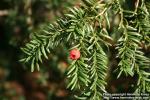
 The leaves and fruit of Taxus baccata, Linné.
The leaves and fruit of Taxus baccata, Linné.
Nat. Ord.—Coniferae.
COMMON NAME: Yew tree.
ILLUSTRATION: Bentley and Trimen, Med. Plants, 253.
Botanical Source and History.—The common yew is a large evergreen tree, native throughout Europe, and very commonly planted as an ornamental tree in church yards, cemeteries, etc., especially in England. It is of very slow growth, and has a hard, close-grained wood that is much used by cabinet-makers. The branches are long and horizontal, the lowest ones proceeding from the trunk at only a few feet from the ground. The bark is of a dark-brown color, and does not split longitudinally, like the bark of most trees, but scales off in thin plates. The flowers appear in early spring, and the male and female are borne on separate trees. The male are in axillary aments, and consist, each, of a thickened axis, having anther-bearing bracts on the upper half, surrounded at the base by imbricated scales. The female flowers are, each, a single sessile, naked, ovule, without either style or stigma, surrounded at the base by a circular disk, which becomes fleshy in the fruit. The fruit is a single oval seed, covered, excepting at the apex, by a thick, fleshy, red cup, and resembles an abortive acorn surrounded by its cup. The cups of the yew fruit are sweetish, though unpleasant to the taste, often, however, being eaten by children. The leaves are very numerous, linear, about ½ inch long, and 1/12 inch wide, sharp, dark-green above, lighter beneath, alternate, and are curved outwardly and upwardly.
An American variety (var. Canadensis, Gray) of the Taxus baccata, is a small shrub, found growing in shady, moist places in Canada and the northern parts of the United States.
History.—Excepting the pulp of the fruit, all parts of the yew tree are poisonous. Pliny, Dioscorides, and other ancient writers, mention the poisonous properties of the leaves and seed, and it has been recorded that wine, preserved in casks made of its wood, has occasioned the death of those who drank it. Strabon states that the Gauls used the juice of the leaves as a poison for their arrows. More recent observations have confirmed the statements as to its toxic character and we frequently read of animals and birds that have been poisoned by the leaves and berries. It is likewise stated that the exhalation emanating from the tree may occasion vertigo, lethargy, and a kind of drunkenness, and that even death may ensue to those who carelessly sleep beneath its branches. Prof. Redwood read a paper before the Pharmaceutical Society of Great Britain (1877), citing the fatal result from drinking a decoction of the leaves.
Chemical Composition.—The poisonous principle of yew resides in an alkaloid taxine, first isolated from the leaves by H. Lucas (Archiv der Pharm., 1856, Vol. CXXXV, p. 145), and later from the leaves and fruits by Marmé (Amer. Jour. Pharm., 1876, p. 353), and by A. Hilger and Fr. Brande (ibid., 1890, p. 297). According to Marmé, it is a white crystalline powder, little soluble in water, soluble in ether, alcohol, chloroform, etc.; insoluble in petroleum-ether. It melts at 80° C. (176° F.), and produces a red color with concentrated sulphuric acid. Amato and Caparelli (ibid., 1881, p. 56) obtained from the leaves a probably similar alkaloid, volatile oil, and a non-nitrogenous, crystalline substance, which they called milouin.
Action, Medical Uses, and Dosage.—The symptoms occasioned by the juice or extract of the leaves, vary according to the quantity that has been taken. In large doses, there is pallor, vertigo, spasm, and symptoms of collapse, with gastric and enteric irritation, enfeebled and deranged cardiac action, coma, and death. Not unfrequently, very large doses are followed by a prompt diminution of the vital forces, or by positive syncope, in either case speedily terminating in death, without any of the severe symptoms of irritation being manifested. Post-mortem investigations have found some indications of inflammation of the stomach and bowels, of active renal congestion, and of diminished heart-power, with a greater or lesser deprivation of the coagulable quality of the blood. It has been used in the attempt to produce abortion, but always fruitlessly, and in some instances has proved a fatal experiment. In cases of poisoning by the ingestion of this article, it should be promptly removed from the stomach by emesis, after which milk or other bland drinks may be administered, at the same time sustaining the strength, if necessary, by the prudent exhibition of stimulants. The red berries are not injurious. Percy, in former times, prepared a jelly and a syrup from them, which he used in cough, chronic bronchitis, and to relieve the pain in calculous nephritis. The leaves have likewise been recommended in certain maladies, which it is unnecessary to name, as we have no satisfactory evidence of their efficacy. The leaves have been given in doses of 1 to 5 grains; or the infusion may be given corresponding in dosage.

